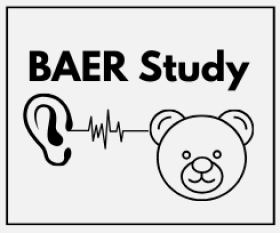BAER Study

The BAER Study is a sub-study to the Cycled Phototherapy Trial, involving a hearing test using Brainstem Auditory Evoked Responses (BAER). This study measures how the speed of a baby’s brain response to sound is affected by bilirubin in the blood. Bilirubin, an orange-yellow pigment resulting from the breakdown of red blood cells, is typically excreted in urine and stool. Excess bilirubin crossing into the brain can accumulate in the brainstem area responsible for hearing and motor functioning and cause permanent brain damage or kernicterus.
The BAER test is done when your baby is at least 36 weeks of age or before leaving the hospital. It is performed while the baby is asleep or quiet and typically takes no more than 30-60 minutes to complete. During the test, three electrodes, like those used for monitoring heart rate, are placed on your baby’s forehead, and earphones are placed over their ears. Clicking sounds are then played, and a machine records the baby’s brain wave responses to the sound. The test is painless and does not cause any harm.
Purpose & Aim
Population of the study: Extremely preterm infants <27 weeks’ gestation or ≤750 grams birthweight
Intervention: Cycled phototherapy
Control (Usual care in our hospital): Continuous phototherapy
Outcome: BAER measures at 36 weeks
Trial Information
Target Enrollment: Largest feasible sample size
Sponsor: NIH Center for Clinical and Translational Sciences (NCATS), NICHD Neonatal Research Network
Funder: NIH NCATS KL2 Career Development Award (5KL2TR003168), July 2021 – July 2024; NIH NICHD Neonatal Research Network (NRN)
Duration of Study: July 2020 – September 2025
Study Principal Investigator

Assistant Professor
Department of Pediatrics, Division of Neonatology
Institute for Clinical Research and Learning Health Care
6431 Fannin, MSB 3.236
Houston, TX 77030
(p): 713-500-6422
Lindsay.N.Fleig@uth.tmc.edu